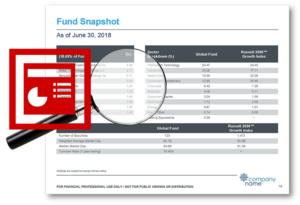Four, No FIVE things to Look for in a Content Automation Solution

I’ve written and spoken frequently in the past about what asset management firms should be looking for as they evaluate content automation for production of their templated literature; fact sheets, commentaries, sales ideas, pitch decks etc. Indeed, this article is largely an update of one I wrote in 2021. I feel compelled to revisit the topic today, however, because of one key thing that seems to be driving a lot of decision making in the market today.
The four things described in the original blog remain as on point today as they were in 2021: data source flexibility, data visualization power, real scalability, and integration capabilities.
The fifth item is hidden in the discussion of the original four and I feel it should be brought to the forefront. And that item is: the total long-term cost of ownership of the solution.
Total Cost of Ownership
The strategic goals for implementing an automation solution are; 1) to reduce time to market for the materials, and 2) to reduce the costs associated with literature production and maintenance. These goals could be called universal.
The familiar refrain we hear is “We want to free up resources to do more strategic work… or at least stop adding production staff to the team as we grow.”
The first attribute to look for in choosing a content automation solution is its ability to meet both goals. How much of the arduous work of standing up the solution or operating it is going to fall to your team? Who’s going to do that work? Does the new solution truly simplify the production process or just change the nature of the work? And, most specifically, will you need to add people to your team to manage the technology?
It’s possible you need more staff to support strategic planning and execution of your growing literature strategy… these functions don’t happen without strong people in place… but you should not need to add new staff whose job description is primarily to operate the new system.
The vendor will likely say “No! You’ll be fine. Our system is so easy to use you can support the thing AND have time to do new work.”
But is this really true?
We’ve seen many marketing operations teams grow rather than shrink (or stabilize) as a direct result of the automation solution they chose. Sometimes the tool causes the IT team to grow as well. If that’s the case, chances are you aren’t meeting either your time to market goals OR your cost savings goals. You should think hard and ask very detailed questions about the workload required by the system you’re implementing.
Not all content automation solutions are created equal. Focusing on the four criteria below should help you to land on a solution which is going to meet your strategic goals. Just be sure that the production and IT workload on the company will genuinely be shrinking as you bring on the automation.
1 . Data source flexibility
A surprising number of content automation tools are not much better than Microsoft Office when it comes to importing data. Just as a location in a Word or PowerPoint document can be mapped to a cell in an Excel spreadsheet, these tools simply pull the data, as is, into the document. An automation solution that does not include loading normalized data into a real database for reference by the publishing engine is going to be challenging to setup data for… and difficult to maintain. Any system that is requiring very rigid import file formats, data be perfectly formatted before loading, or requires loading the data separately for each document set… will have trouble when it comes to scaling up the solution and supporting it.
In contrast, some solutions perform “smart” database-driven data imports and transformations using structured query language (SQL). They can accept data inputs in just about any form and format, then return the exact right output, in the right format, for the right document. This type of solution significantly reduces the need for time-intensive manual data review each quarter and dramatically reduces the risk of errors.
Much is made these days of creating modern API connections between output systems and source systems. APIs are great and can create efficiencies between output systems and source systems. However, unless the API integrations are based on standard endpoints or data workflow tools, they might be adding more effort to setup and maintenance than they save. Additionally, real-time exchange of data between systems creates real-time system dependencies and new concerns around audit trail and governance/control. These concerns need to be managed to in planning the integration. When it comes to data source integration, our advice is to keep it simple… until a newer/better way is up and running and proven.
2. Data visualization
Some content automation solutions offer only simple desktop publishing charting capabilities, like those in Microsoft Excel, which don’t allow for a high degree of customization. To get the look you want, you’ll likely need a professional graphic designer to make refinements using design software, such as Adobe InDesign. But those additional resource hours can offset the efficiencies gained with your content automation solution. Some firms compromise by removing charts and graphics when they implement a content automation tool. We consider this a mistake. Documents that are too dense with text and numbers can be difficult for your audience to digest, decreasing their value as sales tools. In fact, many firms rely on unique and compelling charts and graphs to help differentiate themselves from their competition.
If you don’t want to give up the ability to generate eye-catching visuals, look for a content automation solution with strong native charting and graphics capabilities. The solution you choose needs to be able to create a distinct, high-quality, vector-base charts and graphs which are fully automated, data smart, ADA compliant, and most importantly… beautiful.
Speaking of ADA compliance, in planning your charts and graphs today you need to also look at requirements related the Americans with Disabilities Act (ADA). Graphs representing data sets need to be produced to include “Alt Text” which will be read aloud to a visually impaired consumer by a screen reader. For dynamic charts and graphs, the automation should push data in a readable format into the Alt Text tags just as it does into a chart template. This can be challenging for many systems, especially those that don’t have a proper data warehouse at their core.
3. Real scalability
Some desktop publishing tools offer data and content mapping plug-ins, but they fall short of “true automation”. These less-sophisticated solutions may make sense for some firms. For example, if your published page counts are very low, the total resource-hours you spend creating materials, even over many quarters, might not add up enough to justify a big upfront investment in a sophisticated content tool. Desktop solutions may also make sense if you’re unable to come to a real consensus on your templates and designs, causing your department to enact an endless series of manual changes. Successful automation requires a commitment to standards and some firms just aren’t ready for that.
If you publish large volumes of materials, or generate multiple related types of materials in parallel, and have the discipline to embrace templatizing your materials, look for a solution that’s fundamentally designed to support these criteria efficiently. Over time, the greater efficiencies from a true automation solution add up to a lower total cost of ownership than tools with a lower initial price tag but less sophisticated capabilities.
4. Integration capabilities
Most asset managers rely on multiple technologies to help them effectively perform a wide range of marketing and sales functions. In addition to content automation, they likely need tools for email marketing automation, sales enablement, portfolio accounting, records management, compliance workflow, marketing database support and customer relationship management (CRM). No single system can effectively do it all.
Some vendors offer a multi-purpose tool that puts itself in the center of your data universe, controlling all the data flows. Some tools don’t integrate at all with other platforms and require that you use the vendor’s other proprietary tools. When building your technology stack, you should look for a best-in-class tool for each required function, while also prioritizing its ability to integrate with your entire technology ecosystem.
Here are some related resources that might interest you:






 Compare the Top 3 Finserv Content Automation Vendors [White paper]
Compare the Top 3 Finserv Content Automation Vendors [White paper] Create Pitchbooks the Drive Sales [White paper]
Create Pitchbooks the Drive Sales [White paper] Build vs. Buy: Should Your Financial Services Firm Outsource or Insource Marketing Technology? [White paper]
Build vs. Buy: Should Your Financial Services Firm Outsource or Insource Marketing Technology? [White paper]  10 Tips for Rebranding your Fund Marketing Documents [White paper]
10 Tips for Rebranding your Fund Marketing Documents [White paper]


